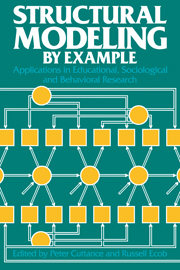Book contents
- Frontmatter
- Contents
- Preface
- List of contributors
- 1 Introduction
- 2 An overview of structural equation modeling
- 3 Field dependence and the differentiation of neurotic syndromes
- 4 High school seniors' reports of parental socioeconomic status: black–white differences
- 5 Modeling the hierarchical structure of learning
- 6 A study of longitudinal causal models comparing gain score analysis with structural equation approaches
- 7 Some structural equation models of sibling resemblance in educational attainment and occupational status
- 8 Applications of structural equation modeling to longitudinal educational data
- 9 The robustness of maximum likelihood estimation in structural equation models
- 10 An inquiry into the effects of outliers on estimates of a structural equation model of basic skills assessment
- 11 Testing structural equation models
- 12 LISREL models for inequality constraints in factor and regression analysis
- 13 Issues and problems in the application of structural equation models
- Appendix
- Glossary
- Index
1 - Introduction
Published online by Cambridge University Press: 12 January 2010
- Frontmatter
- Contents
- Preface
- List of contributors
- 1 Introduction
- 2 An overview of structural equation modeling
- 3 Field dependence and the differentiation of neurotic syndromes
- 4 High school seniors' reports of parental socioeconomic status: black–white differences
- 5 Modeling the hierarchical structure of learning
- 6 A study of longitudinal causal models comparing gain score analysis with structural equation approaches
- 7 Some structural equation models of sibling resemblance in educational attainment and occupational status
- 8 Applications of structural equation modeling to longitudinal educational data
- 9 The robustness of maximum likelihood estimation in structural equation models
- 10 An inquiry into the effects of outliers on estimates of a structural equation model of basic skills assessment
- 11 Testing structural equation models
- 12 LISREL models for inequality constraints in factor and regression analysis
- 13 Issues and problems in the application of structural equation models
- Appendix
- Glossary
- Index
Summary
Structural modeling can be thought of as the marriage of two lines of methodological and statistical development in the social and behavioral sciences. These developments have their seminal roots in early attempts to apply statistical methods to economics and psychology, although similar developments can be observed in other disciplines also. The development of methods for the interpretation of data from widespread mental testing of adult populations in North America and Britain went hand in hand with the development of theories of mental ability. In order to test the efficacy of the various theories of mental ability put forward, the statistical model known today as factor analysis was developed. Since it was evident that a single test item could not tap the full extent of a person's ability in any given area, several items were employed jointly to measure ability. The variation that was common or shared among the items was interpreted as a measure of the underlying ability. Different sets of items were designed as measures of each of the mental abilities hypothesized by the alternative theories. The covariation among these underlying abilities (which were called factors or constructs) was then interpreted in terms of the evidence it provided for the alternative hierarchical and relational models of human abilities put forward in the research.
One aspect of these early models that has been carried over to structural modeling is the idea that a latent construct or factor can be measured by the responses to a set of items on a test.
- Type
- Chapter
- Information
- Structural Modeling by ExampleApplications in Educational, Sociological, and Behavioral Research, pp. 1 - 8Publisher: Cambridge University PressPrint publication year: 1988



